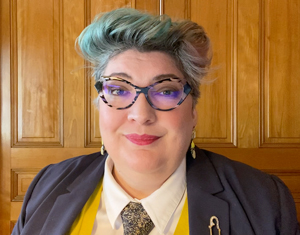UMass Chan anatomist involved in design of 3D female anatomy teaching model
Yasmin Carter was the lead subject matter expert on Elsevier’s Complete Anatomy app
UMass Chan Medical School anatomist Yasmin Carter, PhD, has played a lead role in designing a new three-dimensional full female model on research publishing firm Elsevier’s Complete Anatomy app, the first ever on the platform. The addition of a new 3D female model to the app provides an important educational tool, one that makes clear that female anatomy is distinct.

Dr. Carter, assistant professor of radiology in the Division of Translational Anatomy, was the lead subject matter expert on the Complete Anatomy female model, a role that grew out of her work on Elsevier’s virtual anatomy advisory board. Carter appears in Elsevier’s video about the model and has been interviewed for the online publication Healthline and on Scripps television networks.
She said digital anatomy models based on men have been used as unisex.
“What you actually see in textbooks and models is essentially what you would call ‘bikini medicine,’ which is all models are men, except for areas that could be covered by a bikini,” she said.
This approach can have consequences, according to Carter. For example, women have different symptoms of long COVID and are 50 percent more likely to have a missed diagnosis of a heart attack. Differences in even small things, such as women having a greater carrying angle of their elbow, which leads to more injuries and elbow pain, were missing from male-based anatomical models.
The Complete Anatomy app is used by more than 2.5 million registered customers worldwide. It is used in more than 350 universities globally; the Lamar Soutter Library provides access for all students.
Carter also serves as director of engagement and scholarship in UMass Chan’s DRIVE initiative, which stands for Diversity, Representation and Inclusion for Value in Education, and is the spokesperson for the Vista curriculum Health Equity, Diversity and Inclusion Longitudinal Focus Topic team, supporting integration of areas historically unrepresented and underrepresented in undergraduate medical education.
Carter said she’s motivated to help make better doctors through better education. “But I kept really hitting a boundary of lack of diversity,” she said.
Introduction of a full female model on the Elsevier platform comes as women, since 2019, comprise more than half of all U.S. medical school graduates.
“What happens when you have sex equity in the profession, is we also start to have sex equity in medical education, and I think that’s been huge,” said Carter. “My hope is as we get a more diverse medical profession, representative of our patient population, we’ll get a more diverse and inclusive medical education.”
T.H. Chan School of Medicine adopted a “female-first” curriculum in 2018.
“So in all of the first-year classes, we teach female and then male,” she said. “It’s a micro-change but teaching the female-first curriculum has prompted conversation. In the anatomy course, there is now a half-hour discussion of sex and gender-sensitive medicine, intersex and diversity in anatomy.”